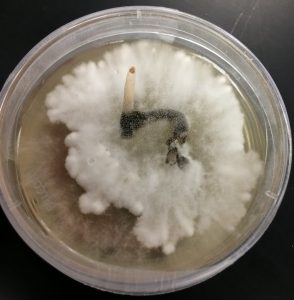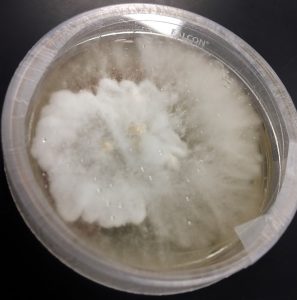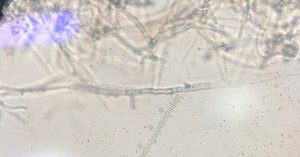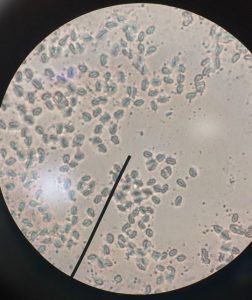Possible ID: Xylaria sp.
Classification:
Phylum: Ascomycota
Class: Sordariomycetes
Order: Xylariales
Family: Xylariaceae
Genus: Xylaria
Isolation and culturing methods:
Isolated from an English Ivy leaf that had been ripped into pieces, soaked in 70% EtOH for approximately 3 minutes, rinsed in autoclaved distilled water, and placed on a malt extract agar plate on February 12th of 2018. Initially, there was no growth from this endophytic fungi for the first couple of weeks. However, after being stored at room temperature for 3 weeks, the endophytic fungal sample burst out of the English Ivy leaf bits and actually began to produce fruiting bodies. Mycelia of the sample were taken from this plate and placed onto its own MEA plate. After Spring break on March 19th of 2018, mycelia were then removed from this plate and transferred to two other separate MEA plates to ensure that a pure culture would be obtained.
Culture appearance and growth:
Fungal endophytic species had mycelia that were mostly white with a somewhat fuzzy, cotton-like texture. However, mycelia were also somewhat fuzzy and brownish in other places as well. Samples grew relatively quickly along the surface of and even into the substrate, almost covering the surface of the medium within two week. Hyphae were septate with no clamp connections and were relatively thin, measuring around 2-8 μm wide. Fruiting bodies that were dark brown and somewhat fuzzy towards the base gave way to long, thin, light pink spore-producing structures.
Growth after 2 weeks:


*Microscopic image of septate hyphae taken at 400x

Spore production:
Light pink packets of spores were produced by the fruiting bodies described above. Spores were green and were ellipsoid to sub-allantoid in shape, measuring around 1-2 x 4-5 μm.
*Microscopic images of spores taken at 400x and 1000x


*Addendum: After sequencing the DNA of this fungal species and blasting it on the NCBI database, evidence was found to suggest that this fungal species is actually in the Family Sordariaceae. Moreover, a fungal endophyte on the database that had previously been isolated had genetic material that was 99% similar to the DNA sequence used for this endophytic fungus.
Collector: Tommy Brouse Group: Andriana, Tommy, AJ